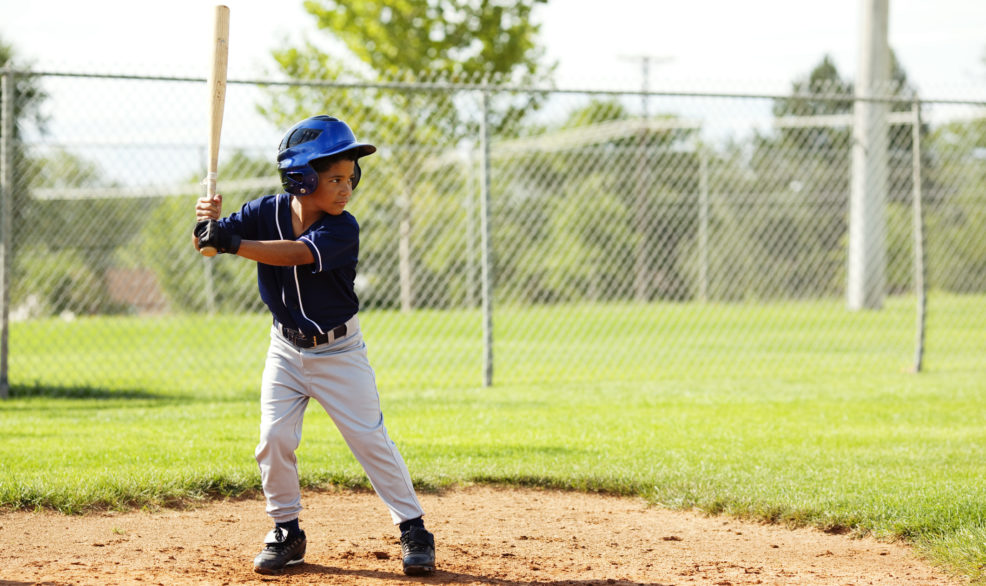When you think of sports injuries in kids, things like concussions, sprains and broken bones likely come to mind. But with one in three youth athletes affected, injuries to the teeth and mouth are also high on the list, explains Parvathi Pokala, D.D.S., a pediatric dentist at Rady Children’s Hospital-San Diego. With Children’s Dental Health Month upon us and springtime sports season fast approaching, learn more about how you can help your champions’ favorite activities play nice with their smiles.
Play Ball (Carefully)
In terms of common culprits, “baseball and basketball have the highest incidence of oral injuries,” states Dr. Pokala. “Baseball injuries [typically] result from direct contact of the baseball to the face. Basketball injuries … are more likely to result from impact with other players.” However, no activity is immune to injury. “Bear in mind that riding a bike or scooter and trampoline activity can result in orofacial injuries,” she continues, “[and] one of the worst injuries I saw was in a child that was sledding … and hit a tree.” Soccer, wrestling, softball, volleyball, lacrosse, football, gymnastics and hockey can also be on the riskier side[1].
Dr. Pokala says that “the majority of [sports-related] injuries affect the upper lip, upper jaw and upper front teeth, [and] up to 90 percent of orofacial injuries involve the maxillary incisors,” which are the upper front teeth. She lists the most typical injuries as follows:
- Fractured teeth and roots
- Tooth avulsion (tooth dislodged lost from the socket)
- Tooth concussion, in which the tooth suffers a powerful blow but is not dislodged
- Tooth luxation, in which the tooth is pushed to the side
- Tooth intrusion, in which the tooth is pushed into its supporting bone
- Jaw fractures
Get Into Gear
Treating orofacial issues is often an involved process, particularly with permanent teeth. “[This] can require extensive treatment including root canal therapy, crowns, extractions of non-savable teeth, implants or partial dentures,” outlines Dr. Pokala. Ouch!
So, what can parents and coaches do to help athletes stay safe? “Even with protective gear, there may be some injuries, but they are usually minimal,” Dr. Pokala expresses. “Overall, mouth guards and helmets reduce injuries and help avoid the high cost of treatment and long-term care.” But there’s a bit of a caveat — kids aren’t likely to suit up on their own accord, and most high-risk sports don’t widely regulate equipment use. In fact, according to the American Academy of Pediatric Dentistry (AAPD), only “high school football, lacrosse, and ice hockey require protective equipment1.” As such, and in line with the AAPD’s reporting, Dr. Pokala suggests making wearing such protective gear a condition of participation.
Adults can also benefit from learning how to properly manage orofacial injuries, Dr. Pokala says. For example, in fractures to permanent teeth, broken pieces can often be re-attached if the fragment is salvaged; while immediately pushing a knocked-out tooth back into place, followed by a fast trip to the dentist, can make a significant difference in outcome. “This really has the biggest impact on the long-term prognosis,” Dr. Pokala explains. “Sadly, when the tooth has not been placed back into the socket right away, the … prognosis can be poor.” She emphasizes, however, that this only applies to adult teeth. “Never re-implant a baby tooth.”
Sports are an awesome way for kids to be active, establish strong self-esteem, learn life skills and have fun — just play it safe out there!
[1] American Academy of Pediatric Dentistry: http://www.aapd.org/media/policies_guidelines/p_sports.pdf. Accessed Jan. 23, 2019.
